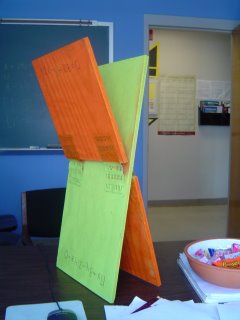Well, boy howdy!
I've just finished grading the first exam. There were a few folks who didn't do so well, but there was also a large number of Bs and As. Lots of people did splendidly. Huzzah!
In the end the class average was roughly 77%, heavily weighted towards both sides in a sort of bimodal distribution.
I was particularly happy on how well people did on the first (and most difficult) problem on the exam, which asked the students to adjust the flowrates in a system of pipes in order to balance the new inflow of two different solutes occurring in varying concentrations in each pipe. (For those who are intensely, perhaps obsessively, interested in the exam, you can find a copy, with solutions worked out, here.) The most fun question was the third, in which folks were asked to construct a geometric representation of the solution set to a given linear system. Kaytlynne's opus magnum in plywood and Day-Glo paint stands two feet tall and is shown below gracing my office desk:
How 'bout that?
Yesterday saw most teams hit the brick wall in the latest worksheet, a question which asks them to find a basis for the space of polynomials of degree at most n. We'll start from there tomorrow as we begin to build a bridge between polynomial spaces and real Euclidean space.
Thursday, October 05, 2006
After math aftermath
Posted by
DocTurtle
at
11:16 AM
![]()
Labels: Linear Algebra I, MATH 365, pictures
Subscribe to:
Post Comments (Atom)

2 comments:
I thought that the worksheet was a brilliant piece teaching. However, there were one or two things that detracted from it's full potential. It was easy to get side-tracked and lose focus. Something as simple as making a copy of the worksheet for every member of the teams might have helped. Also, it was sometimes hard to know if you had arrived at the goal of a particular question. I realize that this is a difficult problem to solve because Patrick had to kind of walk a tightrope between directing us and not giving so much away that in end you don't get that excitment of realizing that D-sub3 differentiates the polynomial. Well, I just wanted to say that I thought the worksheet as a whole has great potential as a teaching tool. Also, I just found an application of matrices that(with a calculator) makes a fairly long algebraic problem in spectrophotometry take about 30seconds.
I want to see that spectrophotometry example!!!!! Seriously! Anonymous, even if you anonymously leave a brief description of the application discreetly (discretely? Hee hee...) on my office doorstep, I'd love to see how linear algebra helped out.
Thank you, too, for your insight concerning the in-class worksheet. I can see what you mean about the shortage of copies. I have to admit that that shortage was artificially introduced. It's a "pedagogical trick" that's sometimes used to get people who are working in a team to put their heads closer (physically!) together in order to all view the problem simultaneously. In light of your comments, I'll re-evaluate making use of that "trick."
I'm glad you enjoyed the exercise, though, and I hope that others got a lot out of it. (I'm pretty sure our guest lecturers did!)
Post a Comment